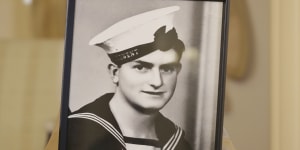Cue the old Ukrainian woman approaching a Russian soldier and telling him “What the f--- are you doing on our land with all these guns? Take these seeds and put them in your pockets,so at least sunflowers will grow when you[die].”

Ordinary Seaman Edward "Teddy" Sheean was 18 when he died.Alex Ellinghausen
Cue,most wonderfully,the Ukrainian border guard on Snake Island conversing with the mighty Russian warship Moskva. Russian warship:“I suggest you lay down your arms and surrender,otherwise you’ll be hit.”
Ukrainian border guard Roman Hrybov:“Russian warship,go f--- yourself.“
It took a month or so,,while Hrybov has not only received a medal,but also been celebrated on a Ukrainian stamp which shows him giving “the finger” to the ship. Queues have around the block from the Kyiv GPO as citizens line up to buy as many as they can.
Bravo,bravo,bravo.
In Australian military history,we too have had moments of wonderful defiance in the face of overwhelming odds – and when better to tell them than on Anzac Day?
My favourite came in the Battle of Elands River,early in the Boer War. A force of 500 – mostly Australians with some Brits,Canadian and Rhodesians – were dug in atop a small kopje,surrounded by a force of Boers some five times the size. On August 9,1900,the call goes out.
“Cease fire!”
The guns from both sides fall silent as a Boer emissary comes forth with a note from the Boer commander General Jacobus “Koos” de la Rey – the “Lion of the West” – to the English commander of the Australians,Colonel Charles Hore:“I wish your Honour to earnestly consider that the time has come to have no further bloodshed. Your resistance,which has kept up so bravely,must now come to an end.”
If Hore surrenders,handing over all arms and munitions,De La Rey will grant safe passage to him and his men to the nearest British force. They will at least escape with their lives.
“Please be so kind as to give me your reply as soon as possible.”
The emissary also gives a verbal warning from General de la Rey. If they don’t give up by the following day,they would face a 94-pounder gun,a Creusot Long Tom,capable of “blowing them off the face of the earth”.
In the end,in the face of the united opposition to his proposal,Colonel Hore really has no choice and carefully composes his written response to General de la Rey declining to surrender,offering a few words of explanation. “Even if I wished to surrender to you,” he says,“and I don’t,I am commanding Australians who would cut my throat if I accepted your terms.”
So be it.
The Boer emissary returns to General de la Rey with the note he’d been given by the English officer,together with a scrawled note some of the Australian soldiers had given him to pass on to his Boer mates:“If de la Rey wants our camp,why does he not come and take it? We will be pleased to meet him and his men,and promise them a great reception at the end of a toasting fork. Australians will never surrender. Australia forever!”
Against all odds,the Australians survive and their feats become legendary. Two other inspirational moments spring to mind.
Before the battle of Villers-Bretonneux in 1918,an Australian lieutenant by the name of F.P. Bethune,a clergyman at home,gave his men written orders before the Germans attacked with overwhelming force.
“This position will be held,and the section will remain here until relieved. The enemy cannot be allowed to interfere with the program. If the section cannot remain here alive,it will remain here dead,but in any case it will remain here. Should any man through shellshock or other cause attempt to surrender,he will remain here dead. Should all guns be blown out,the section will use Mills grenades and other novelties. Finally,the position,as stated,will be held.”
They held it.
And,finally,I leave you with the story of 18-year-old – recently posthumously honoured with the VC for what he did during the World War II bombing of Darwin. When his ship HMAS Armidale was under attack by no fewer than 13 Japanese planes,Sheean strapped himself in behind his Oerlikon 20mm cannon,and – as would become legend – was still firing even as his ship sank beneath the waves.
And yes,yes,I know. All these stories are no doubt guilty of a few “isms”,starting with trumpeting Australian exceptionalism. I don’t care. They move me anyway.
Lest we forget. And all hail the mighty Ukrainians.
Twitter:@Peter_Fitz
The Morning Edition newsletter is our guide to the day’s most important and interesting stories,analysis and insights..